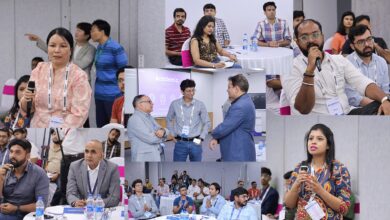Introduction to Data Science Life Cycle

Introduction to Data Science Life Cycle
In an era characterized by an incessant flow of digital information, the potential of data to revolutionize industries is boundless. From social media interactions to online transactions, this data possesses the capacity to empower businesses and organizations with invaluable insights, enabling them to make well-informed decisions and gain a competitive edge. Yet, the process of converting raw data into actionable intelligence is far from automatic. This is where the Data Science Lifecycle steps in – a systematic and strategic approach that unravels the mysteries behind data and transforms it into tangible insights.
This article will take you through the Data Science Lifecycle, demystifying its stages and shedding light on their significance. But before that we recommend you to improve your skills by taking up a Data Science Course.
Stage 1: Defining the Conundrum
Imagine data science as a grand puzzle. Every puzzle needs a clear picture of the final arrangement to guide the assembly process. Similarly, the first step in the Data Science Lifecycle involves defining the problem at hand. Businesses and organizations need to articulate the challenges they wish to overcome or the objectives they seek to achieve. For instance, a retail giant might strive to optimize inventory management, while a healthcare institution might aim to forecast patient readmissions. The cruciality of this stage lies in setting the trajectory for the entire data science journey.
Stage 2: Gathering the Data Gems
With the problem delineated, it’s time to embark on a data expedition. Data comes in various forms – structured (organized in tables) or unstructured (like text and images). Organizations often possess their own repositories of data, but external sources or web scraping might also contribute to the dataset. Ensuring data quality and relevance is paramount, as insights derived from poor-quality data can be grossly inaccurate and misleading.
Stage 3: Unveiling Patterns through Cleaning and Exploration
The reality of raw data is often messy. Errors, missing values, and inconsistencies are common contaminants. Data cleaning is akin to polishing rough diamonds – it’s the process of identifying and rectifying anomalies to ensure the accuracy of subsequent analyses. After a spick-and-span dataset is achieved, data exploration takes center stage. This involves delving deep into the data to uncover patterns, correlations, and potential insights. Visual aids like graphs and charts prove instrumental in comprehending intricate data structures and trends.
Stage 4: Crafting Features for Model Mastery
Think of this stage as sculpting raw marble into a masterpiece. Data scientists identify key variables, known as features, that serve as the building blocks of predictive models. These features are instrumental in influencing the performance of models in later stages. Feature engineering might involve data transformation, creation of new attributes, or the selection of the most pertinent ones. For instance, in a predictive model for customer churn, relevant features could encompass customer demographics, purchasing history, and interactions with customer service.
Stage 5: Constructing the Model Tapestry
Armed with well-crafted features, the stage is set for constructing models – algorithms that learn from data to make predictions or decisions. The selection of algorithms is akin to an artist’s choice of medium – it depends on the nature of the problem and the intricacies of the data. Decision trees, neural networks, and support vector machines are a few examples from the expansive repertoire of algorithms. Model building is iterative, involving training, testing, and refining models to achieve optimal performance.
Stage 6: Putting Models to the Litmus Test
The journey doesn’t halt at model construction; it merely transforms. The performance of models is rigorously evaluated in this stage, using metrics like recall, accuracy, precision, and F1-score. These metrics provide insights into the model’s efficacy in predicting outcomes accurately. If the model’s performance falls short, it’s back to the drawing board for further refinement and enhancement.
Stage 7: From Virtual to Reality – Deployment
With a polished model in hand, it’s time to infuse life into it. Deployment involves integrating the model into operational processes to enable real-time predictions or decisions. Whether it’s suggesting products to users or detecting fraudulent activities, the deployed model should seamlessly assimilate into existing workflows. Continuous monitoring ensures the model maintains consistent performance over time.
Stage 8: Deciphering and Conveying Insights
Deciphering the intricate insights extracted from complex data models and effectively conveying them in understandable terms is a pivotal stage within the Data Science Lifecycle. This phase acts as a crucial bridge between the technical intricacies of data analysis and the practical realm of decision-making. It is at this juncture that the raw power of data transforms into actionable wisdom.
Data-driven insights hold value only when they guide action. During this stage, data scientists translate complex model outputs into comprehensible insights for non-technical stakeholders. Visual aids resurface to present results in an easily digestible format. Clear communication bridges the gap between technical intricacies and practical implementation, empowering organizations to make judicious decisions.
Stage 9: From Insight to Impact
Ultimately, the Data Science Lifecycle’s culmination lies in driving tangible action and creating value. The insights gleaned from data steer decision-makers toward strategic choices that benefit the organization. Whether it’s refining marketing campaigns, enhancing product offerings, or elevating customer experiences, data science insights possess the potency to tangibly influence the bottom line.
Concluding Thoughts
In a world inundated with data, the Data Science Lifecycle emerges as the guiding compass that steers organizations toward transformative insights. From defining problems and collecting data to constructing models and taking actionable steps, each stage orchestrates a symphony that harmonizes the potential of data with organizational success.
By embracing and understanding this lifecycle, businesses can harness the powers of data and wield it as a competitive advantage in an ever-evolving landscape. And surely a Data Science Training can be helpful you to know the real powers of data.



